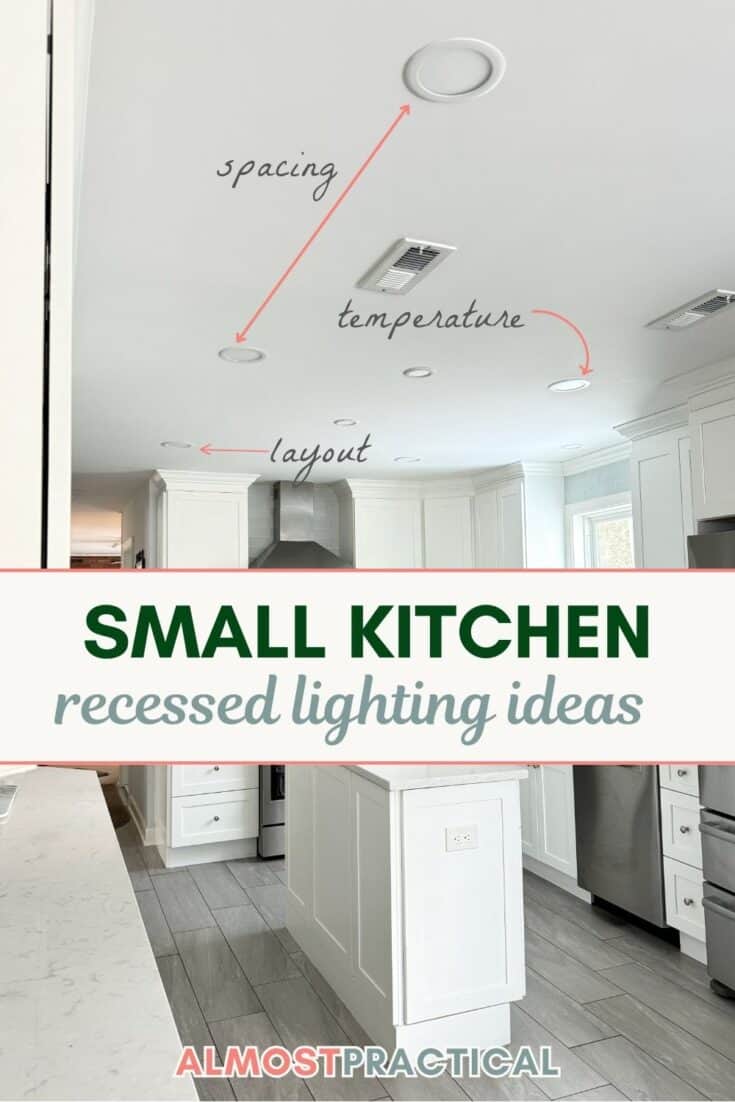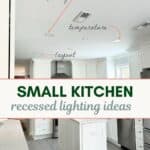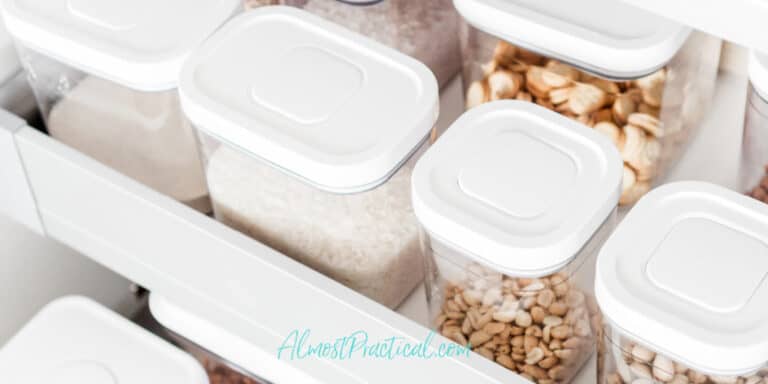The Recessed Lighting I Chose In My Kitchen Remodel
This post may contain affiliate links which means I make a commission if you shop through my links.
Disclosure Policy
Here are some things to consider if you are planning to redo your recess lighting in a kitchen remodel or renovation.
We recently renovated our smallish kitchen with 8 foot ceilings and decided to go with recessed lighting throughout. Meaning – we did not install any pendants or other type of hanging fixture.
It was a tough decision for me, since there are so many beautiful choices in lighting out there.
But given the size of our kitchen I thought that going the recessed route was best. In this post I will walk you through our decision process and also how we determined the placement and layout of them on the ceiling.
Hopefully, this will give some ideas if you are planning on changing or upgrading the lighting in your own kitchen.

Lighting Challenges Created by a Small Kitchen
Small kitchens are challenging in so many ways. The obvious reason is the limited space that you have for food preparation, storage, dishes, and appliances. But one not so obvious limitation is lighting.
We have all seen the gorgeous, magazine worthy kitchens on Pinterest that have high ceilings and beautiful pendant lights over the kitchen island.
These, combined with a mix of recessed lights, under-cabinet lighting, and possibly a few wall sconces mixed in, all work together to create warm ambient lighting and give the space a modern look.
It is definitely inspiring.
So, when we went through our recent remodel, I was pretty excited to incorporate all of these different types of lights into my kitchen design.
However, the reality is that the space in my kitchen is limited and my home, which was built in the 1970’s, has low 8-foot ceilings.
The only real option for me was to install recessed lights or flush mount type ceiling fixtures.
Quick Tour of Our Kitchen
To give you an idea of the space that I am dealing with, I will give you a quick tour of our kitchen from a lighting perspective.
We have an L Shaped design with the stove on one wall and the sink on the wall that is perpendicular. At one point this was an eat in kitchen with a wall separating it from the formal dining room.
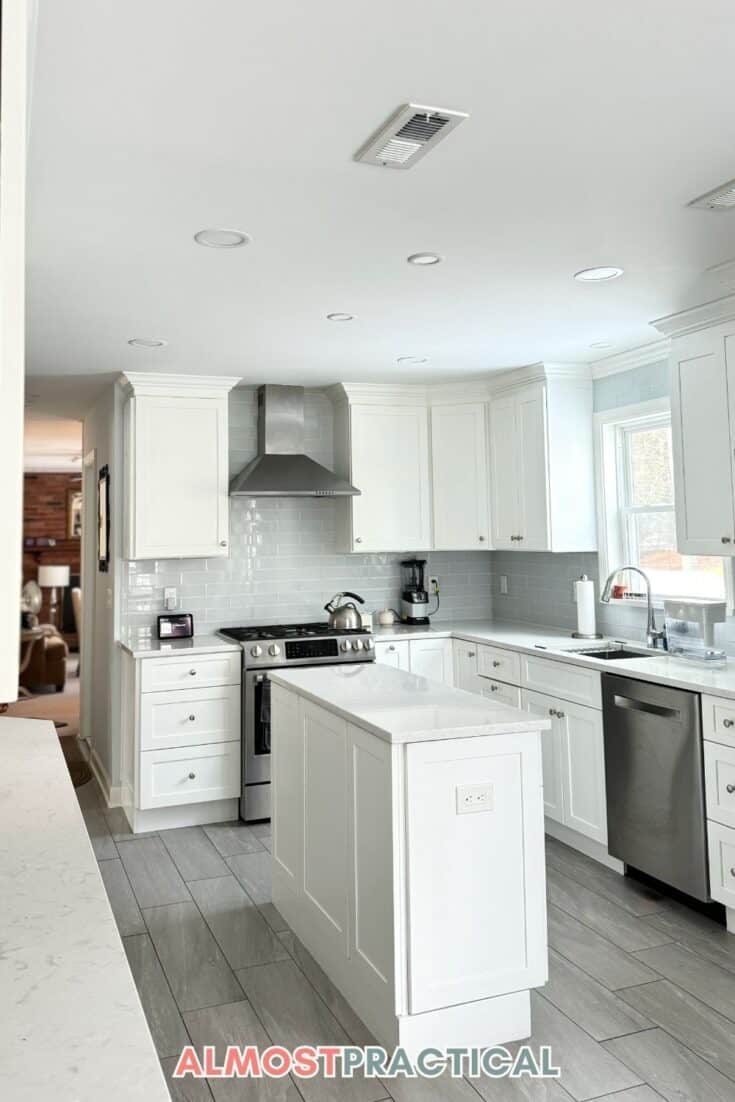
However, when our fourth child was born, we removed that wall and converted the dining room to the only eating space and added a counter with cabinets above and below along the wall opposite the sink.
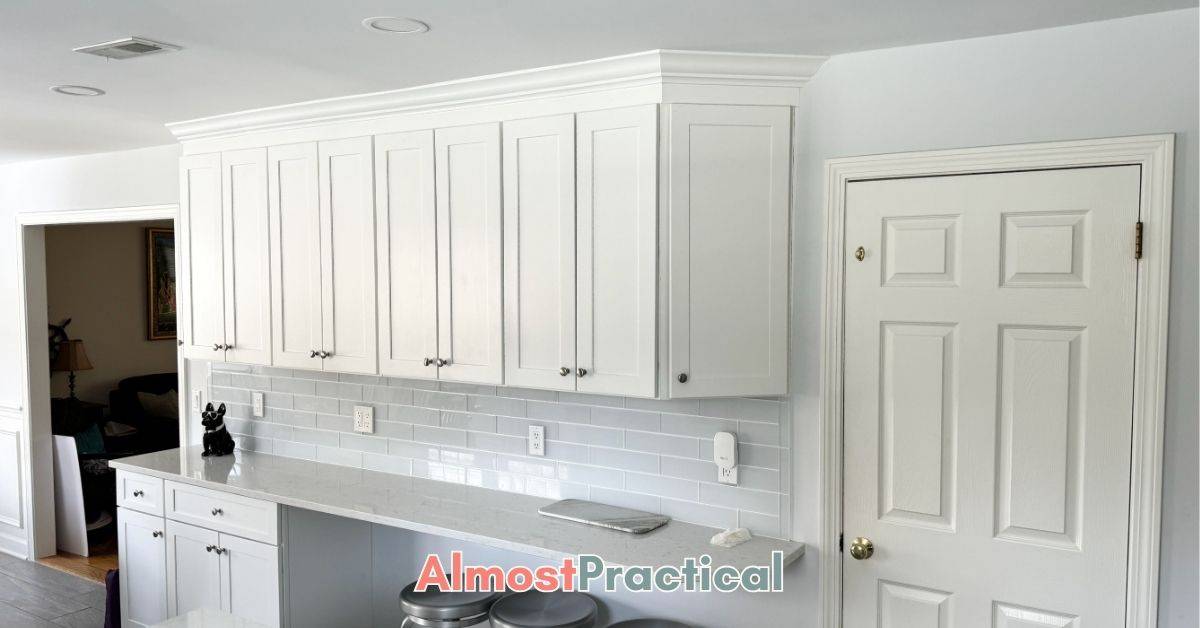
Fast forward 20 years and we decided to renovate the space and squeeze in a small kitchen island.
So, while we by no means have a tiny kitchen (as a result of the previous renovation), the actual square footage of the part we use for cooking is not huge.
Why We Chose Recessed Lights
The primary reasons that we decided to use recessed lighting throughout our kitchen are these:
- It provides bright light for this very much used work and gathering space
- Any dangling pendant lights would interfere with sight lines
- It is budget friendly
Given the traffic patterns in our kitchen, people would hit their heads on pendant lights if they were installed anywhere except over the kitchen island and the kitchen sink.
But our kitchen island is smack dab in the middle of a narrow room – so any lights that dangle down over the island would cause a visual obstruction as you look across the room.
I felt that this would make the kitchen look more cluttered and crowded – and I did not want pendant lighting to become the focal point.
Similarly, we could have done a pretty single bulb chandelier or flush mount lights over the kitchen sink – but we have a double hung window here and I periodically open the top panel inward for cleaning. So, I didn’t want the light fixture to get in the way.
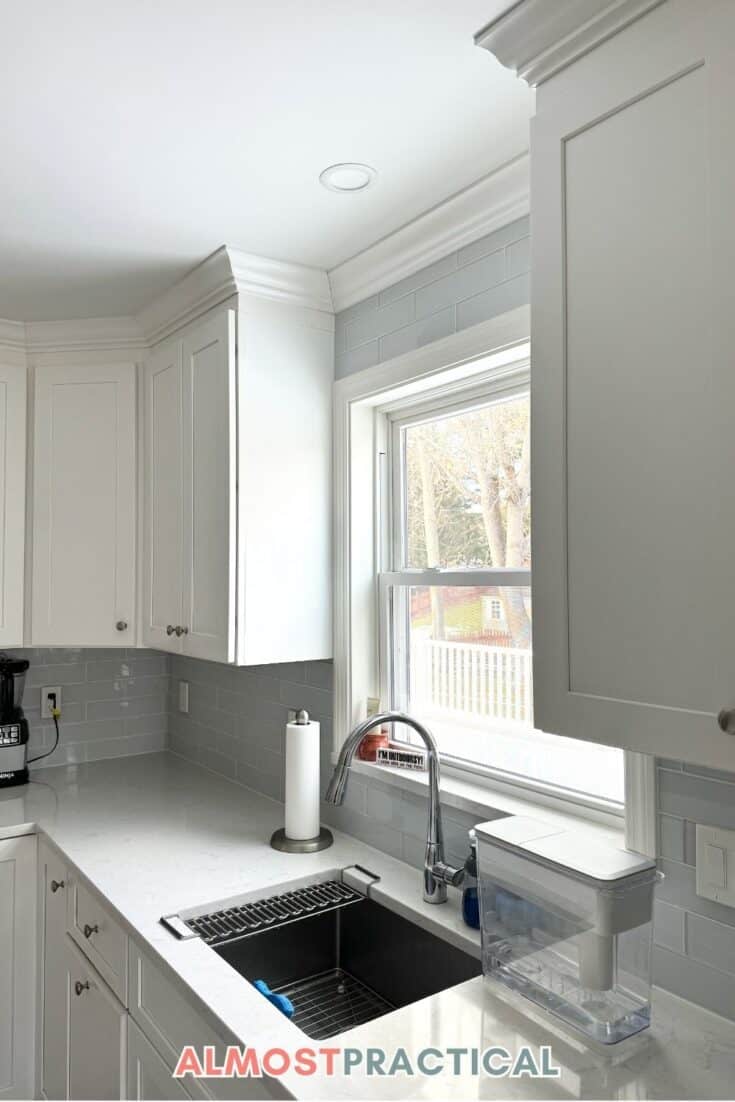
Another alternative to recessed lights is to use a flush mount light fixture in the center of the kitchen to light the whole space. This can work well in a really small kitchen if you combine it with some under cabinet lights to give you enough task lighting on your countertops.
However, I feel that a center light still gives you dark corners around the perimeter of your kitchen, especially near the counter spaces. And this is where you really need the most light.
So, at the end of the day, I decided to go with recessed lighting throughout my entire kitchen and satisfied my desire for fancy lighting by hanging a chandelier over the dining table, instead.
Best Spacing and Layout for the Ceiling Lights
There are a few things to consider when determining the placement of your recessed lights.
How Far Apart From Each Other Should They Be
The general rule of thumb according to this article on The Home Depot is to divide the height of your ceiling by 2 – and space your recess lights that distance apart in feet. So, for an 8 foot ceiling, your recessed lights should be 4 feet apart.
How Far Should They Be From The Wall
However, according to this article on Ferguson, remember that the first recessed light from your wall should be half that distance. So, for a kitchen with 8 foot ceilings, the first recessed light in a row will be 2 feet away from the wall (not from the cabinets – but the actual wall that the cabinets are on) and then the next light in that row will be 4 feet away from the previous light.
This is because the light from a recessed light will shine down in a cone shape – so that first light should be closer to the wall so that you have enough light around the edges of the room.
What Type of Layout Do You Want to Achieve

Think about how many rows and columns of lights you need for your space.
Since my kitchen is narrow, it made sense to use two rows of three recess lights each. However, the island is in the center – but a third row through the center of the room would have been too many.
So, to light up the area over the island, I decided to go with two recess lights of a smaller diameter to set them apart.
Another Consideration: Cans vs Canless Fixtures
When we redid the lighting in our kitchen, my basic understanding was that we had two choices for the recessed lights – we could use traditional cans or these new-to-me canless recessed LED lighting fixtures.
My electrician pointed out a few pros and cons that I would not have otherwise thought of.
One of the big advantages of canless lights is that they do not need to be secured to a beam – so they are both easier to install and most importantly – easy to place wherever you might want them to be. They are also known for their energy efficiency.
The upside (or disadvantage) depending on how you look at it – is that canless lights do not have a replaceable bulb – but they are long lasting. This gives the room a very sleek look.
Cans on the other hand give the bulb and wiring a protective housing and you can use incandescent light bulbs, fluorescent bulbs, halogen, or LED’s inside them.
Of course, the reality is that there are so many different types of recessed lighting!
We Also Added Dimmers

Once you have come up with a lighting plan, you should consider the types of switches and dimmers that you want to use.
At full power, recessed lights can be very bright.
And there will be times when you want a little mood lighting in your kitchen – so it is nice if you can control this brightness.
Using dimmers and separate switches is a great way to keep the option of having a lot of llight for when you need it, but also being able to tone it down for when you want a softer look.
The best ways to do this are as follows.
First, you can create zones by putting subgroups of the lights on different switches and second, you can use dimmer switches.
For my kitchen lights, I put the 6 main lights on one switch, the two over the island on a second switch, and the one over the sink on its own switch.
I also used dimmer switches on the main set of lights and the ones over the island.
Your Lighting Color Temperature Makes a Difference
LED lights come in a range of color temperatures – from a warm, soft white to a cool, bright daylight. The range of colors is measured by something called Kelvins – so you will see this measurement on the package of the lights or bulbs you are looking at. This article on TCPI.com explains it really well.
Bulbs with a lower Kelvin rating produce a warmer tone and more yellow light. Conversely, bulbs with a higher kelvin rating display a cooler more white light.
The range is usually between 2400K on the low end and 6500K on the high end.
If you read my article on the best basement lighting color temperatures, you will see that I went with 3000K bulbs. It is a finished basement that we use as a second living room, so I didn’t want the light to be too harsh, but I also wanted to brighten up this dark area.
In a kitchen installation, you want the lights to be bright enough for task lighting but not too harsh.
I have a photo of the box from the lights we used, but it doesn’t specify the kelvins – rather it just says Bright White. In my online research, I believe that the temperature is 4000K but I am not 100 percent certain.
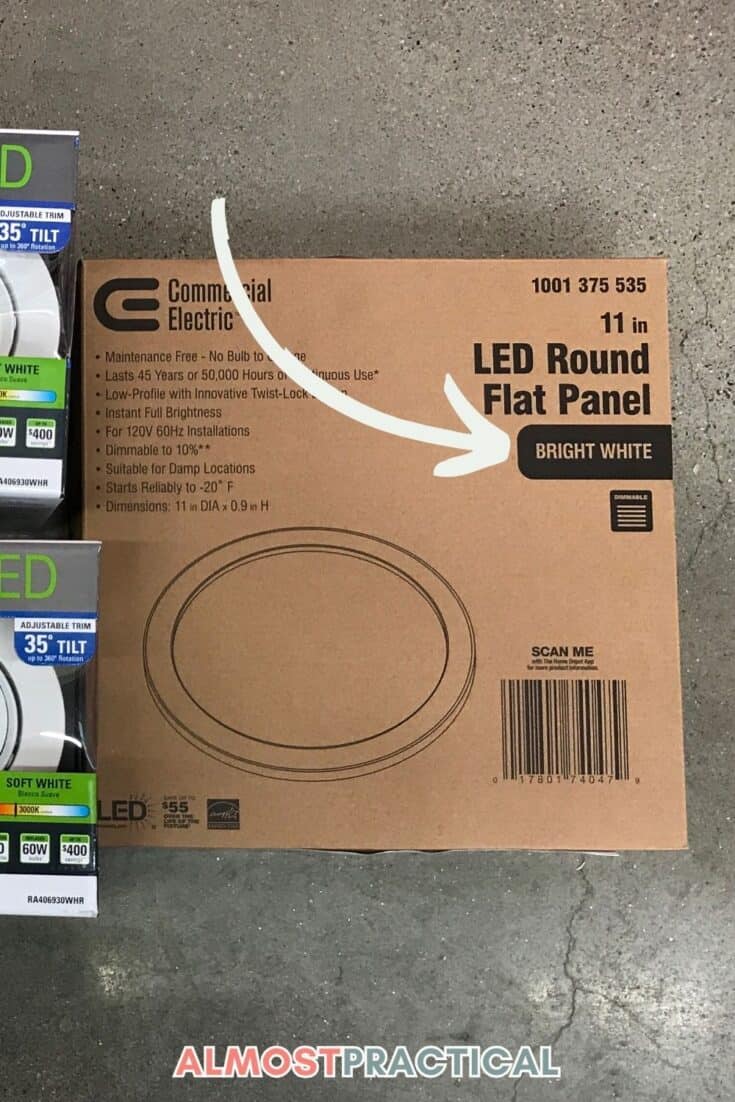
Choose Lighting to Fit Your Small Kitchen
The first thing to consider when choosing recessed lighting for your kitchen is usability.
Make sure that the type of lights you choose fit your lifestyle.
Be sure to create a good lighting plan that includes the following:
- The number, spacing and layout of your recessed lights,
- Whether you will use can or canless light fixtures,
- The dimmers and switches you will use, and
- a color temperature that is appealing to you and that also lights up your work areas well.
Let us know about your small kitchen lighting ideas in the comments below!
